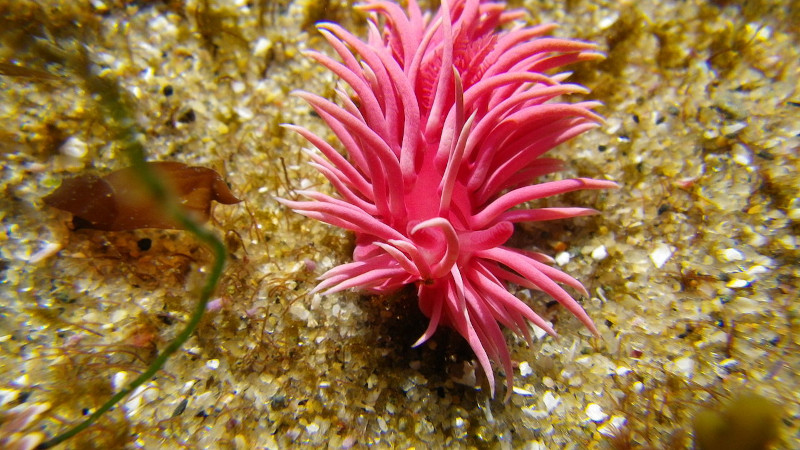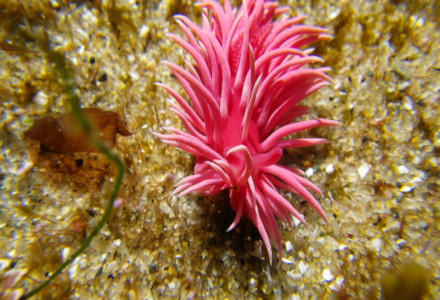
Hopkin’s Rose nudibranch Facts
- This unique creature, with the startling appearance, most frequently goes by the descriptive common name of the Hopkin’s Rose nudibranch. For the moment, the uniquely evolved small marine gastropod has no other accepted general name.
- Professionals, such as researchers, however, typically refer to the animal by its formal name. Fortunately for us, though, that term’s easier to pronounce than most official names. That’s because the mollusc bears the technical name of the Okenia rosacea.
- The American malacologist, Frank Mace Macfarland, made the first formal recognition of the creature. He acknowledged it as a separate and distinct species following in-depth research. This scientifically noteworthy accomplishment occured in 1905.
- He further placed the animal, a variety of sea slug, in the Family Goniodorididae. There, it joins numerous other amazing species. Regardless of classification, or which term one chooses to employ, however, it remains as fascinating as it is beautiful.
- For the moment, the IUCN has no listing for the Hopkin’s Rose nudibranch. Any such listing would appear on the organization’s published Red List. Presently, data on its precise current population, along with trends in that regard, remains insufficient.
- It may be considered to be facing the same threats as other species, though. The nature of its habitat range likely augments such factors, as well. Like most forms of life on earth, its greatest threat probably consists of the ongoing effects of climate change.
Related Articles
Hopkin’s Rose nudibranch Physical Description
The stunning Hopkin’s Rose nudibranch quickly captivates those who encounter it. While it does so for various reasons, sheer size, however, isn’t among them. That’s due to the fact that it remains a relatively small species. Yet size typically matters little in Nature.
Unlike most forms of animal life on earth, this creature displays no sexual dimorphism. That’s actually not surprising, however, given its classification. That’s due to the fact that, like its many related species, this remarkable animal evolved as hermaphroditic.
Since it has both male and female characteristics, gender-based physical differences are not a factor. All specimens therefore present the same basic general appearance, with only minor variations between individuals. It evolved an amazing physical form, though.
Regarding its size, however, the colorful creature remains quite small. Mature specimens attain an average total body length of approximately 1.2 in (3 cm). Evolution therefore made the most of what it had to work with, in terms of its purely visual distinctiveness.
The head, foot, and mantle of the Hopkin’s Rose nudibranch developed as merged into a single profile. That further possesses a generally flattened shape. It also has a grand total of 20 gills. Unlike many of its relatives, though, it completely lacks any oral tentacles.
Its the color pattern of the animal that garners the most attention, however. Numerous long papillae cover its back and sides. These present a rather brilliant shade of pink. That’s also often highlighted by a bright white tip. The combination produces a dazzling effect.
- Kingdom: Animalia
- Phylum: Mollusca
- Class: Gastropoda
- Order: Heterobranchia
- Family: Goniodorididae
- Genus: Okenia
- Species: O. rosacea
Hopkin’s Rose nudibranch Distribution, Habitat, and Ecology
Unfortunately, the Hopkin’s Rose nudibranch has a very limited zone of habitation. That’s true since it appears to have evolved as native to only a highly restricted portion of the globe. Presently, its only known range consists of a small part of the Pacific Ocean.
More precisely, the only area in which it’s ever been seen occurs along a section of the western coast of North America. Thee, the gastropod makes its home along the shoreline on the United States. It lives from Monterey Bay, California, to the coast of Oregon.
Even there, however, its own nature severely limits where it appears. That holds true due to the fact that it lives only in the intertidal zone. In fact, all known specimens appear at depths of no more than 19.7 ft (6 m). This obviously limits its chances of expansion.
It further demonstrates even more specific preferences, though it will appear in all parts of this range if necessary. As a general principle, though, the animal seems to prefer rocky regions. It also apparently has a preference for tidepools along open coast areas.
The mesmerizing Hopkin’s Rose nudibranch feeds almost exclusively on a specific type of prey. This consists of a variety of simple, aquatic invertebrates known as bryozoans. It also feeds almost exclusively on a single species, named the Eurystomella bilabiata.
During mating, one hermaphrodite acts as the male, and the other the female. The resulting eggs are later deposited on a secure spot of the ocean floor. After hatching, these further progress from the larval stage to that of a mature adult. Its lifespan remains undetermined.
Species Sharing Its Range
Check out our other articles on 5 Fully Fabulous Frogs, European Honey Buzzard, Dune du Pilat, Honey Badger, Smooth Purple Coneflower, African Monarch, Saltwater Crocodile

